Nobody Can Cuss like a Titmouse
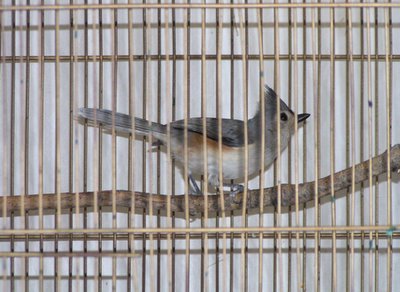
I do a bit of songbird rehabilitation, and have done it all my life. When I was a kid, I had no idea one had to have state and federal permits to handle wild birds. I just cleaned up what the neighbor's seventeen cats wrought, replacing baby birds in nests, trying to set broken wings, raising those who had been orphaned. I learned a lot from my father, who was raised on a farm and knew so much about how to nurture creatures. We came up with a formula, fed through an ear syringe, that raised a nice, fat mourning dove when I was in high school, because Dad knew that pigeons feed their young by regurgitation, and we went from there.
Now, I have all the pieces of paper that make such pursuits legal, and while I don't seek out busted birds, they come to me through a variety of channels. Either I find them or people know someone who knows that I might be able to help. I got a call on Sunday, January 15, about a titmouse that couldn't fly. The couple who found it suspected a window strike, but the limp wing and the fact that many of its upper tail coverts were missing led me to suspect that a cat was responsible for the injury. Later, they mentioned that they have two free-roaming cats, but that the cats didn't kill birds. They were the nicest folks, so I let that statement go, and allowed as how a sharp-shinned or Cooper's hawk might have done the deed. One thing I know--a window doesn't grab birds from behind. And a hawk isn't likely to leave its prey on the porch and then ask to come inside. Free-roaming cats. Agggh. Sorry, but evidence suggests that even the fat, innocent-looking ones kill birds.
So this titmouse was bright and active but reduced to scuttling around on the floor of his cage, his left wing hanging.
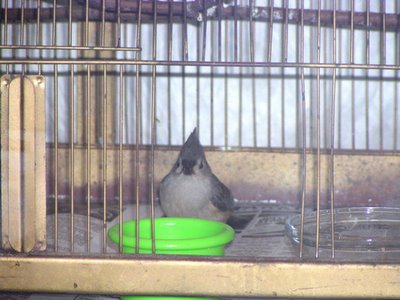 I wet him down thoroughly and examined him, finding massive bruising above the left scapula, but no obvious breaks or bruising in the wings. And almost went deaf as he cussed me up and down. In a wing exam, I manipulate the wing bones and listen for crepitation--the sound of broken bones rubbing on each other. With this patient, there was no way I was going to hear it, he was so vocal! His wings checked out fine. If the scapula or shoulder wasn't broken, he might just be all right. And if the gods willed it, he'd be releasable. You can't mess too much with the delicate bones, muscles and nerves in songbirds' wings and get a functional wing out of it. I decided to keep him confined to a small cage, keep him as quiet as possible, and see what about 1,500 mealworms and a couple of weeks' rest would do for the injury.
I wet him down thoroughly and examined him, finding massive bruising above the left scapula, but no obvious breaks or bruising in the wings. And almost went deaf as he cussed me up and down. In a wing exam, I manipulate the wing bones and listen for crepitation--the sound of broken bones rubbing on each other. With this patient, there was no way I was going to hear it, he was so vocal! His wings checked out fine. If the scapula or shoulder wasn't broken, he might just be all right. And if the gods willed it, he'd be releasable. You can't mess too much with the delicate bones, muscles and nerves in songbirds' wings and get a functional wing out of it. I decided to keep him confined to a small cage, keep him as quiet as possible, and see what about 1,500 mealworms and a couple of weeks' rest would do for the injury.There comes a moment in a bird's rehabilitation arc when you walk in and you KNOW he's ready to go. This titmouse was ricocheting off the bars of the cage, more every day, and I saw him stretch both wings up over his back. The droop had disappeared; he was eating us out of house and home, and he was hitting the sides of the cage so hard as he flew around that I knew it was time to release him before he damaged himself. You need to release them when they're sufficiently healed, but before they lose their wild edge. This picture shows both wings engaged as he shoots up from the floor of the cage.
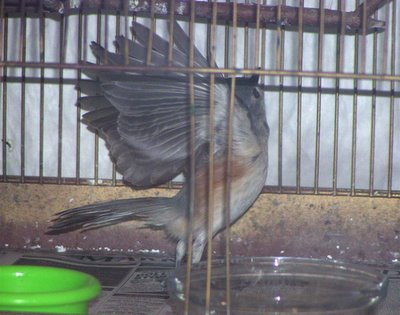
So he got his flight test in my 10 x 10' aviary this morning, and passed it. He clung to the screen, wanting out!
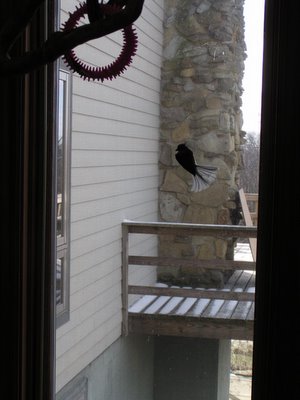 I wanted to release him in the front yard where he could see all the feeders, and the other titmice coming to them. I wasn't about to send him back where he was first injured, for obvious reasons. I figured it's better he start a new life on a cat-free sanctuary than hang out in his old haunts and risk getting nailed again.
I wanted to release him in the front yard where he could see all the feeders, and the other titmice coming to them. I wasn't about to send him back where he was first injured, for obvious reasons. I figured it's better he start a new life on a cat-free sanctuary than hang out in his old haunts and risk getting nailed again.So Bill snapped a couple of release day photos--I had to be having a bad hair day AND wearing my Sesame Street fashions, didn't I?
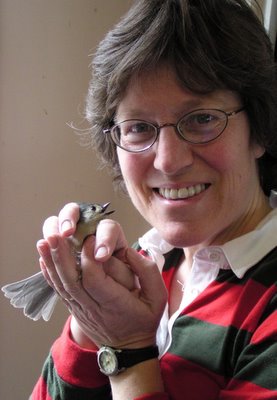 Man, could he cuss! Oh, I am such a glamourpuss.Trying to let the world's worst haircut grow out enough to be fixed. This shot should take care of any potential stalkers.
Man, could he cuss! Oh, I am such a glamourpuss.Trying to let the world's worst haircut grow out enough to be fixed. This shot should take care of any potential stalkers.We took the titmouse out in the yard. He flew all the way across the yard, with a slight twist of the left wing, but he flew high and well, certainly well enough for a nonmigratory bird who moves from tree to tree in the forest. He rested awhile in the forsythia, where several juncos came to keep him company, then flew to the Russian prune hedge. I went out to try to get a picture of him fluffing, wiping his bill, and preening, and he flew right over my head, back toward the feeders (a distance of perhaps 50 yards), paused a moment in a little birch,
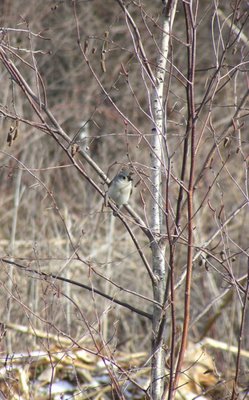 then landed on the peanut feeder!
then landed on the peanut feeder!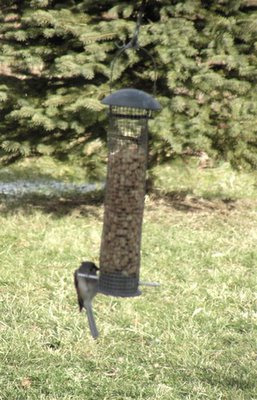 If I hadn't seen it with my own eyes, I'd never have believed it. What a guy. Has it all figured out within ten minutes of release. People should get on with their lives as handily. All the feeder birds spooked, and he rocketed into the woods with three or four other titmice. Not all rehab stories end so well. Now I'll be peering at every titmouse I see, wondering if it's him. O happy, happy day! Making the world a nicer place, one titmouse at a time.
If I hadn't seen it with my own eyes, I'd never have believed it. What a guy. Has it all figured out within ten minutes of release. People should get on with their lives as handily. All the feeder birds spooked, and he rocketed into the woods with three or four other titmice. Not all rehab stories end so well. Now I'll be peering at every titmouse I see, wondering if it's him. O happy, happy day! Making the world a nicer place, one titmouse at a time.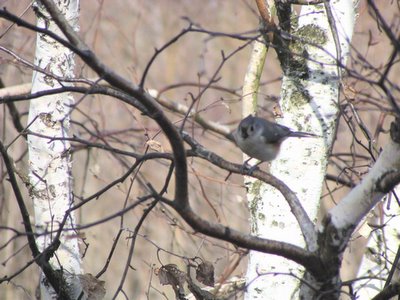






<< Home